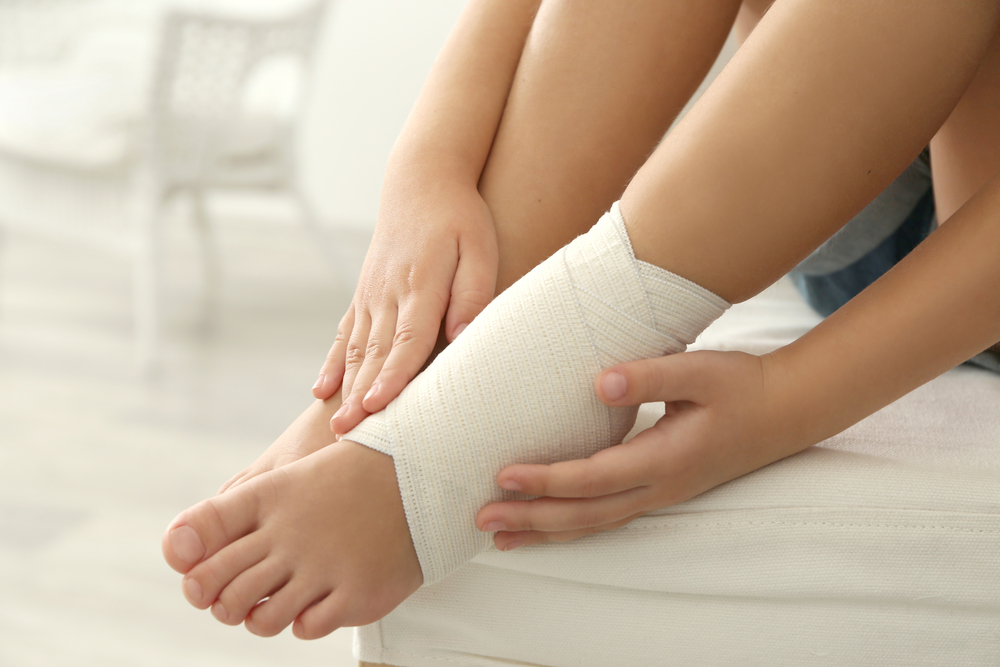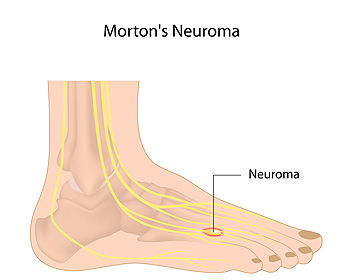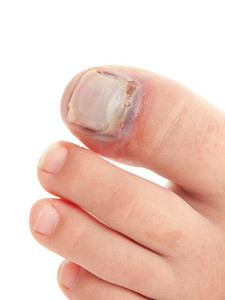Items filtered by date: August 2019
A Common Form of Ankle Pain is Sprains
 Ankle pain can occur for a variety of reasons. A large percentage of ankle pain often includes ankle sprains, and this typically happens if the ankle rolls inwards. This can occur as a result of stepping off of a curb unexpectedly, which can cause the ligaments to overstretch and tear. The symptoms of an ankle sprain that many patients experience can include bruising on and around the affected site, swelling and tenderness, and it may even be difficult to walk. When treatment is started, it is important to keep the weight off of the foot as much as possible. This can be accomplished by using crutches, and frequently elevating the foot. Support may be found when an elastic bandage is wrapped around the ankle, or a brace may also be used. An ankle sprain is one form of ankle pain. If you have ankle pain for any reason, it is suggested to speak to a podiatrist who can offer the best treatment options.
Ankle pain can occur for a variety of reasons. A large percentage of ankle pain often includes ankle sprains, and this typically happens if the ankle rolls inwards. This can occur as a result of stepping off of a curb unexpectedly, which can cause the ligaments to overstretch and tear. The symptoms of an ankle sprain that many patients experience can include bruising on and around the affected site, swelling and tenderness, and it may even be difficult to walk. When treatment is started, it is important to keep the weight off of the foot as much as possible. This can be accomplished by using crutches, and frequently elevating the foot. Support may be found when an elastic bandage is wrapped around the ankle, or a brace may also be used. An ankle sprain is one form of ankle pain. If you have ankle pain for any reason, it is suggested to speak to a podiatrist who can offer the best treatment options.
Ankle pain can have many different causes and the pain may potentially be serious. If you have ankle pain, consult with Dr. Mark Gagnon from Advanced Podiatry. Our doctor will assess your condition and provide you with quality foot and ankle treatment.
Ankle pain is any condition that causes pain in the ankle. Due to the fact that the ankle consists of tendons, muscles, bones, and ligaments, ankle pain can come from a number of different conditions.
Causes
The most common causes of ankle pain include:
- Types of arthritis (rheumatoid, osteoarthritis, and gout)
- Ankle sprains
- Broken ankles
- Achilles tendinitis
- Achilles tendon rupture
- Stress fractures
- Tarsal tunnel syndrome
- Plantar fasciitis
Symptoms
Symptoms of ankle injury vary based upon the condition. Pain may include general pain and discomfort, swelling, aching, redness, bruising, burning or stabbing sensations, and/or loss of sensation.
Diagnosis
Due to the wide variety of potential causes of ankle pain, podiatrists will utilize a number of different methods to properly diagnose ankle pain. This can include asking for personal and family medical histories and of any recent injuries. Further diagnosis may include sensation tests, a physical examination, and potentially x-rays or other imaging tests.
Treatment
Just as the range of causes varies widely, so do treatments. Some more common treatments are rest, ice packs, keeping pressure off the foot, orthotics and braces, medication for inflammation and pain, and surgery.
If you have any questions, please feel free to contact one of our offices located in Crestwood, Orland Park, and Summit, IL . We offer the newest diagnostic and treatment technologies for all your foot care needs.
How Does Toenail Fungus Enter The Body?
 A toenail fungus is considered to be an infection of the nails. Common symptoms that are often associated with this condition can include noticeable discoloration of the toenails, and they may appear thick. Additionally, many patients see their nails beginning to crack, and this can cause an unsightly appearance. This type of fungus is known to be contagious, and typically lives and thrives in warm and moist environments. These often include public swimming pools and surrounding areas, shower room floors, and locker rooms. The fungus can enter through tiny cracks in the skin, and the toenails can gradually become affected. Patients who are diabetic or have a weakened immune system may be more likely to contract this type of fungus. There are methods that can be implemented which may help to prevent the fungus from entering the body. These include wearing appropriate shoes while in public areas, and avoiding sharing shoes, socks, or nail trimmers. If you have toenail fungus, please consult with a podiatrist who can offer proper treatment options.
A toenail fungus is considered to be an infection of the nails. Common symptoms that are often associated with this condition can include noticeable discoloration of the toenails, and they may appear thick. Additionally, many patients see their nails beginning to crack, and this can cause an unsightly appearance. This type of fungus is known to be contagious, and typically lives and thrives in warm and moist environments. These often include public swimming pools and surrounding areas, shower room floors, and locker rooms. The fungus can enter through tiny cracks in the skin, and the toenails can gradually become affected. Patients who are diabetic or have a weakened immune system may be more likely to contract this type of fungus. There are methods that can be implemented which may help to prevent the fungus from entering the body. These include wearing appropriate shoes while in public areas, and avoiding sharing shoes, socks, or nail trimmers. If you have toenail fungus, please consult with a podiatrist who can offer proper treatment options.
If left untreated, toenail fungus may spread to other toenails, skin, or even fingernails. If you suspect you have toenail fungus it is important to seek treatment right away. For more information about treatment, contact Dr. Mark Gagnon of Advanced Podiatry. Our doctor can provide the care you need to keep you pain-free and on your feet.
Symptoms
- Warped or oddly shaped nails
- Yellowish nails
- Loose/separated nail
- Buildup of bits and pieces of nail fragments under the nail
- Brittle, broken, thickened nail
Treatment
If self-care strategies and over-the-counter medications does not help your fungus, your podiatrist may give you a prescription drug instead. Even if you find relief from your toenail fungus symptoms, you may experience a repeat infection in the future.
Prevention
In order to prevent getting toenail fungus in the future, you should always make sure to wash your feet with soap and water. After washing, it is important to dry your feet thoroughly especially in between the toes. When trimming your toenails, be sure to trim straight across instead of in a rounded shape. It is crucial not to cover up discolored nails with nail polish because that will prevent your nail from being able to “breathe”.
In some cases, surgical procedure may be needed to remove the toenail fungus. Consult with your podiatrist about the best treatment options for your case of toenail fungus.
If you have any questions, please feel free to contact one of our offices located in Crestwood, Orland Park, and Summit, IL . We offer the newest diagnostic and treatment technologies for all your foot care needs.
Nerve Damage May Lead to Morton’s Neuroma
 Pain and discomfort that is felt on the ball of the foot may indicate the presence of a condition that is known as Morton’s neuroma. Additionally, the pain may be felt at the base of the toes, and patients have noticed that it feels like they are standing on pebbles. Other symptoms can include numbness or tingling, and walking may be difficult. A common cause of this condition is wearing shoes that are too tight, and which do not have adequate room for the toes to move freely in. Wearing these types of shoes can cause irritation in the nerve, gradually putting pressure on that portion of the foot. There are existing medical conditions that are often associated with Morton’s neuroma. These can include bunions, hammertoes, and flat feet. After a proper diagnosis is performed, mild relief can be found in performing stretching techniques that may be helpful in loosening the tendons, in addition to elevating and massaging the affected foot. Please consult with a podiatrist if you feel you may have developed Morton’s neuroma, so that the proper treatment can begin.
Pain and discomfort that is felt on the ball of the foot may indicate the presence of a condition that is known as Morton’s neuroma. Additionally, the pain may be felt at the base of the toes, and patients have noticed that it feels like they are standing on pebbles. Other symptoms can include numbness or tingling, and walking may be difficult. A common cause of this condition is wearing shoes that are too tight, and which do not have adequate room for the toes to move freely in. Wearing these types of shoes can cause irritation in the nerve, gradually putting pressure on that portion of the foot. There are existing medical conditions that are often associated with Morton’s neuroma. These can include bunions, hammertoes, and flat feet. After a proper diagnosis is performed, mild relief can be found in performing stretching techniques that may be helpful in loosening the tendons, in addition to elevating and massaging the affected foot. Please consult with a podiatrist if you feel you may have developed Morton’s neuroma, so that the proper treatment can begin.
Morton’s neuroma is a very uncomfortable condition to live with. If you think you have Morton’s neuroma, contact Dr. Mark Gagnon of Advanced Podiatry. Our doctor will attend to all of your foot care needs and answer any of your related questions.
Morton’s Neuroma
Morton's neuroma is a painful foot condition that commonly affects the areas between the second and third or third and fourth toe, although other areas of the foot are also susceptible. Morton’s neuroma is caused by an inflamed nerve in the foot that is being squeezed and aggravated by surrounding bones.
What Increases the Chances of Having Morton’s Neuroma?
- Ill-fitting high heels or shoes that add pressure to the toe or foot
- Jogging, running or any sport that involves constant impact to the foot
- Flat feet, bunions, and any other foot deformities
Morton’s neuroma is a very treatable condition. Orthotics and shoe inserts can often be used to alleviate the pain on the forefront of the feet. In more severe cases, corticosteroids can also be prescribed. In order to figure out the best treatment for your neuroma, it’s recommended to seek the care of a podiatrist who can diagnose your condition and provide different treatment options.
If you have any questions, please feel free to contact one of our offices located in Crestwood, Orland Park, and Summit, IL . We offer the newest diagnostic and treatment technologies for all your foot care needs.
Possible Causes of Heel Spurs
If you are experiencing heel pain, it may be indicative of a condition that is referred to as a heel spur. It is defined as a bony growth that can be hooked or pointed, and grows underneath the heel. Some of the symptoms that are associated with heel spurs consist of pain that is felt after arising in the morning, inflammation and tenderness surrounding the affected area, and warmth near the heel. This ailment occurs as a result of strained muscles and ligaments that damage the soft tissues in the heel. They may form from the aging process, participating in running and jumping activities, or wearing shoes that do not fit correctly. If you feel you may have developed a heel spur, it is advised that you consult with a podiatrist who can properly diagnosis and treat this condition.
Heel spurs can be incredibly painful and sometimes may make you unable to participate in physical activities. To get medical care for your heel spurs, contact Dr. Mark Gagnon from Advanced Podiatry. Our doctor will do everything possible to treat your condition.
Heels Spurs
Heel spurs are formed by calcium deposits on the back of the foot where the heel is. This can also be caused by small fragments of bone breaking off one section of the foot, attaching onto the back of the foot. Heel spurs can also be bone growth on the back of the foot and may grow in the direction of the arch of the foot.
Older individuals usually suffer from heel spurs and pain sometimes intensifies with age. One of the main condition's spurs are related to is plantar fasciitis.
Pain
The pain associated with spurs is often because of weight placed on the feet. When someone is walking, their entire weight is concentrated on the feet. Bone spurs then have the tendency to affect other bones and tissues around the foot. As the pain continues, the feet will become tender and sensitive over time.
Treatments
There are many ways to treat heel spurs. If one is suffering from heel spurs in conjunction with pain, there are several methods for healing. Medication, surgery, and herbal care are some options.
If you have any questions feel free to contact one of our offices located in Crestwood, Orland Park, and Summit, IL . We offer the latest in diagnostic and treatment technology to meet your needs.
Symptoms of a Broken Toe
 A broken toe can occur if something heavy is dropped on it, or if you stub it by hitting it against a piece of furniture. Common symptoms that are often associated with this condition can include bruising near and around the affected toe, and there may also be difficulty in walking and putting weight on it. If the toe appears to be bent at an awkward angle, it may be dislocated, and immediate medical attention should be sought. It may also look swollen, and it may be hard to move. After a proper diagnosis is performed, which typically consists of having an X-ray taken, the correct treatment can begin. Many patients find it beneficial to use the method that is known as buddy taping. This is accomplished by taping the injured toe to the toe next to it. This method may be helpful in providing adequate support as the healing process begins. If the fracture is severe enough, then surgery may be necessary to repair the injured toe. If you think you may have broken your toe, it is suggested that you speak to a podiatrist who can offer the correct treatment options.
A broken toe can occur if something heavy is dropped on it, or if you stub it by hitting it against a piece of furniture. Common symptoms that are often associated with this condition can include bruising near and around the affected toe, and there may also be difficulty in walking and putting weight on it. If the toe appears to be bent at an awkward angle, it may be dislocated, and immediate medical attention should be sought. It may also look swollen, and it may be hard to move. After a proper diagnosis is performed, which typically consists of having an X-ray taken, the correct treatment can begin. Many patients find it beneficial to use the method that is known as buddy taping. This is accomplished by taping the injured toe to the toe next to it. This method may be helpful in providing adequate support as the healing process begins. If the fracture is severe enough, then surgery may be necessary to repair the injured toe. If you think you may have broken your toe, it is suggested that you speak to a podiatrist who can offer the correct treatment options.
Broken toes may cause a lot of pain and should be treated as soon as possible. If you have any concerns about your feet, contact Dr. Mark Gagnon from Advanced Podiatry. Our doctor will treat your foot and ankle needs.
What Is a Broken Toe?
A broken toe occurs when one or more of the toe bones of the foot are broken after an injury. Injuries such as stubbing your toe or dropping a heavy object on it may cause a toe fracture.
Symptoms of a Broken Toe
- Swelling
- Pain (with/without wearing shoes)
- Stiffness
- Nail Injury
Although the injured toe should be monitored daily, it is especially important to have a podiatrist look at your toe if you have severe symptoms. Some of these symptoms include worsening or new pain that is not relieved with medication, sores, redness, or open wounds near the toe.
If you have any questions, please feel free to contact one of our offices located in Crestwood, Orland Park, and Summit, IL . We offer the newest diagnostic and treatment technologies for all your foot care needs.


